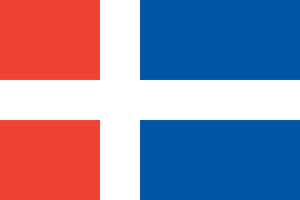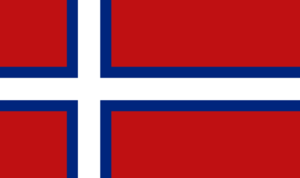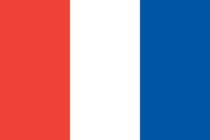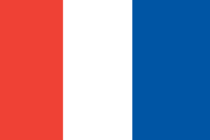Flag of Victoria

The national flag of Victoria is an offset white cross on a coloured field of red and blue.
The current flag was adopted in 1702 AN, following the Declaration of Buthminster, with its design intended to be an amalgamation of two former official flags of Victoria.
Current flag
Adopted in 1702, the current Victorian flag can be seen as a combination of the two previous flags' designs. Utilising the popular off-centre cross last seen in a national Victorian flag in 1583 AN, it sees a white cross segregate sections of red and blue. The shades of the colours used are exact to those which the previous flag—that used under Gotzer and Storish occupation—had codified for it, as listed below.
| Scheme | Red | White | Blue |
|---|---|---|---|
| Pantone | Red 032 | Safe | Reflex Blue |
| CMYK | 0.90.86.0 | 0.0.0.0 | 100.70.0.5 |
| RGB | (250,60,50) | (255,255,255) | (0,85,164) |
| HTML | #EF4135 | #FFFFFF | #0055A4 |
| NCS | S 0580 Y80R | base color | S 2565 R80B |
The symbolism of the current flag mirrors the previous flags that have historically been used. The new design was necessitated in the Declaration of Buthminster due to the association of the "Vicborg" tricolour with the country's Vanic past, from which modern Victorians wished to distance themselves.
Former flags
Vicborg (1606–1685)
The "Vicborg" tricolour was the flag of Victoria used during its time under Gotzer, and subsequently Storish, control. Its design was based around that of the flag of Gotzborg, which also used a vertical tricolour, albeit charged with the lesser arms of the monarch.
The colours were adopted by Dundas on 13.XI.1606 and later received Royal Assent by King August Charles II of Gotzborg.
The flag was 50 percent wider than its height (i.e. in the proportion 2:3) and, except in the Victorian navy, had stripes of equal width.
Unification Flag (1469–1583)

The Act of Unification created the state of the Kingdom of Victoria, later the Victorian Empire, upon the inclusion of the duchies of Buthnock, Glenmaye, Middleton and Orgyle in 1469. The Victorian flag was subsequently updated to include a central white cross, signifying a belief in a peaceful future for all nine duchies.
Unified Kingdoms (1450–1469)

The first known flag of Victoria is that of the inaugural united state, the Unified Kingdoms of Victoria.
The flag's design includes an off-centre cross, which would influence subsequent Victorian national flags, and uses red and blue colouring. The flag's colours originate with the colours of the flags of the five Founding Kingdoms, on which either red or blue, or both, featured. These colours resulted in becoming the national colours of Victoria.
The offset cross design was copied from the flags of two of the five petty kingdoms, Dundahl and Strathalmond, making it a popular feature in Victorian vexillology.

